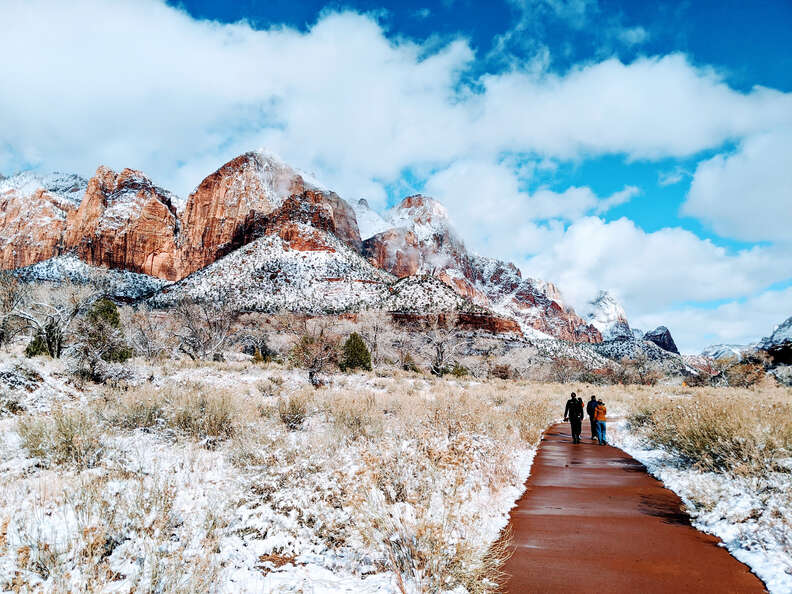These National Parks Are Actually at Their Best in the Winter
All the wonder, none of the crowds.
America’s national parks were established as places where we can experience its awesome power, often in isolation. Tell that to the summer crowds clogging the trails of Zion, or the campfire troubadours whose open mic-caliber guitar playing echoes off of Joshua Tree’s trippy crags until dawn.
The national parks remain America’s Best Idea, and something we all can—and should—enjoy, screaming kids at Old Faithful included. But for those who wish to experience the parks with the same sense of solitude as an antelope, winter can be the best time to go. The trails are clear of obstacles. Campsites might not require a reservation. And, unlike peak season, you'll feel like you have the place all to yourself. These are the parks that are at their absolute best in the winter.
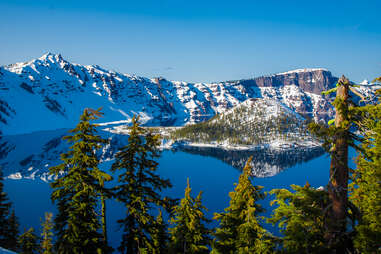
Oregon
Oregon’s only national park is also America’s deepest lake, a 2,000-foot-deep natural wonder whose mirror-like waters transform into the centerpiece of one of the country’s most striking winter landscapes when the cold sets in. Strapping on snowshoes or skis to circumvent the caldera is an ethereal joy that should be on the bucket list of any cold-weather adventurer. Go it alone or take advantage of a quick guided ranger hike. Either way, you’ll flit in and out of dense evergreen forests, emerging to gaze on the waters. Meanwhile Wizard Island, plunked in the middle of the cloud-draped lake, goes full Gandalf, transitioning from gray to white with the snowfall.
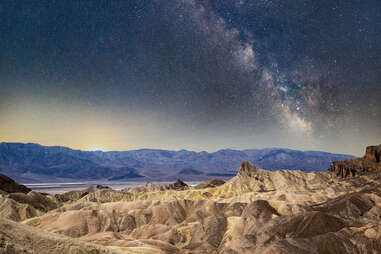
California and Nevada
Death Valley is the hottest place on Earth, so it stands to reason that this park is much more appealing to visit in January, when snow and ice are sometimes present, than in July, when they definitely are not. The park is quietest around the holidays, but you might also consider visiting in February, which is typically when the Death Valley Dark Sky Festival (March 1-3, 2024) reinforces the park’s reputation as one of the best stargazing sites in the country. If you can swing it, aim to visit during a weekend that’s not a long holiday weekend—those have been known to see crowds, even in the winter.
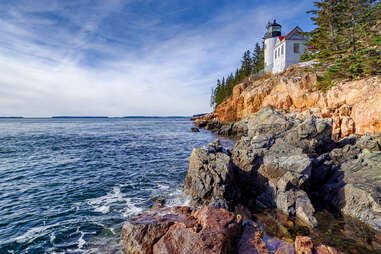
Maine
We’ve said it once and we’ll say it again—interior Maine gets Game of Thrones-level winters, and your ass can and will come out of that wilderness looking like the Night King. But if you stick to the coast, where the weather tends to stay milder, you’ll find yourself in a frosted wonderland that makes up for in wintry views what it lacks in summertime’s blueberry pies. Acadia National Park (and the nearby, perpetually charming town of Bar Harbor) is at the center of that action. You can hike along trails blanketed in snow (bring traction cleats and trekking poles!) or try your hand at cross-country skiing or snowshoeing. Meanwhile, the cold-averse will be glad to hear that the best sights can be reached by car: Though the Park Loop Drive closes during the cold months, ever-scenic Ocean Drive, Sargeant Drive, and Jordan Pond Road all stay open for the season. And if you really want to be wowed, stick around past nightfall: If conditions are right, you might get lucky enough to catch the northern lights.
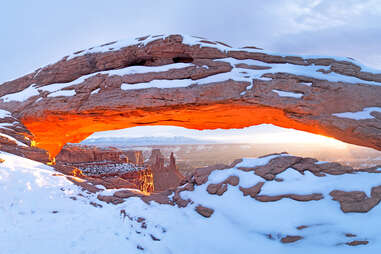
Utah
Spoiler alert: You’re going to see three of Utah’s Big Five on this list. And to clarify, we’d include every single one of them if we had the space. Even with next-door neighbor Arches and NPS behemoth Zion both showing off Grade A sights when temperatures dip each year, Canyonlands stands out as a banger. The largest yet least-visited national park in the state, Canyonlands’ snow-dusted spires, arches, mesa tops, and sandstone cliffs are made all the better by the fact that crowds clear out almost completely come winter, turning this into a place of spectacular, sweeping solitude. (Just be sure to check for road closures before you head out.)
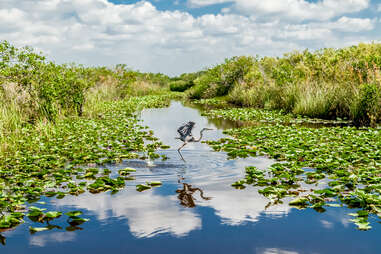
Florida
Okay, so the Everglades didn't make this list due to a reduction in crowds. Winter is actually peak season here. But that’s because it’s truly the loveliest time of year to visit. Temperatures are in the 60s and 70s, the suffocating bugs are thinned out and minimally predatory, and the lower water levels mean that it’s easier than ever to spot alligators and spoonbills and all manner of other critters gathered around watering holes. Check out some guided tours to make the most of your visit.
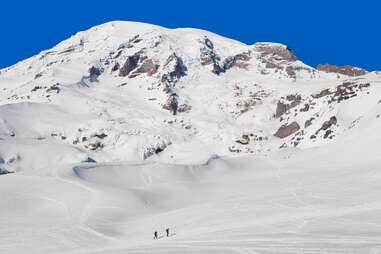
Washington
The Everglades or Biscayne you visit because you want less winter. Mount Rainier, however, you visit because you want more winter. This Washington monolit—which sits conveniently about 2.5 hours from both Portland and Seattle—sees upwards of 50 feet of annual snowfall. That means you’ve got your skiing and snowboarding, your backcountry snowshoeing and camping, your fun-for-the-whole-family sledding and snowmobiling. This is truly a winter wonderland for all tastes, whether you prefer to experience the snow from the comfort of a tent or the warmth of the National Park Inn.
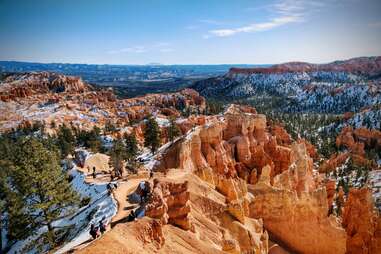
Utah
In the summertime, Zion is basically Disneyland. It’s crowded. It’s hot. You’re standing in two-hour lines to be able to do the one thing you most want to do that day, and they're often out of turkey legs. End this madness and go in the wintertime. Just 13% of Zion visitors journey to the park between November and March, and a wintertime desert is one of nature’s most glorious settings. Even better, once you've had your fill of the park and its legendary trails, you'll be able to explore all the surrounding (and vastly overlooked) state parks unencumbered.
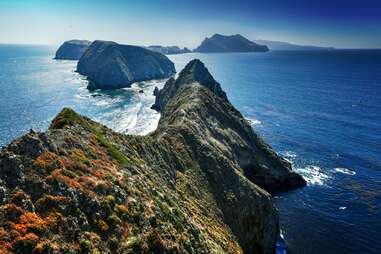
California
Winter means great diving in this national park archipelago, which remains somehow overlooked despite being an easy drive (and boat ride) away from LA. Underwater plants are flowering, and the visibility hasn't yet been disturbed by spring rains. Chilly winter waters mean it’s the right time of year to watch gray whales along their migration routes; if you’re lucky, you might spot a pod of orcas here and there, too. Wintertime in the Channel Islands is also when you can see pelicans nesting, elephant seals and harbor seal pups newly born, and the islands exploding with wildflowers closer to the end of the season.
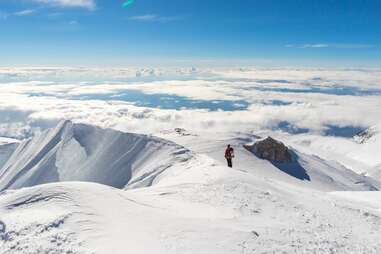
Alaska
Want to see the northern lights? In the US, you can’t do much better than Alaska's massive Denali in the winter. Access to the dog sledding kennels is open on Saturday and Sunday afternoons, permits for backcountry hikes are free, and wildlife viewing is as spectacular as ever. There’s also February's Winterfest, which typically includes dog-sled rides, ice-carving, ranger-led snowshoe walks, cross-country ski races, and more or less every other winter-themed activity one could wish for.
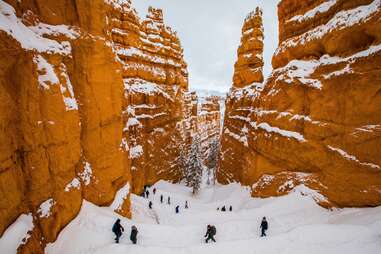
Utah
Bryce is beautiful at any time of year, but if you’ve never seen those famous spires and tent rocks dusted with snow then you owe it to yourself to do so. The entire park is an embarrassment of riches come wintertime. There’s ice fishing, snowmobiling, and the drier air this time of year makes the desert skies unparalleled for stargazing; you’ll find regularly scheduled astronomy programs including full-moon snowshoe hikes at the newly designated International Dark Sky Park. Nowhere else on Earth will you get as vivid a look at Mars overhead while feeling like you're standing on the Red Planet.
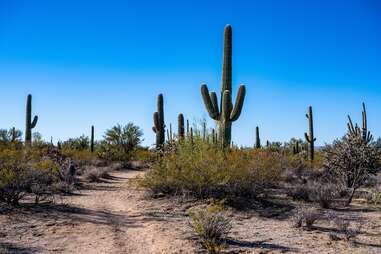
Arizona
Somehow overlooked and under-visited despite its proximity to bustling Tucson, Saguaro’s expanses of cartoonishly contorted cacti and relatively easy hikes are best explored during the winter. In the off season, the already thin crowds dissipate and you’re free to cavort with owls and gaze at petroglyphs with little interruption and minus the oppressive heat. Even better, the campsites—a relatively hot commodity numbering a scant 20—are easier to bag, allowing you to spend the night under the stars with only coyotes (and maybe roadrunners, given the landscape) as your company.
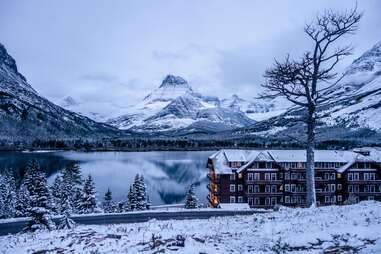
Montana
Snowshoeing, skiing, camping, backcountry camping (provided you have a permit), and, yes, another chance to see the northern lights. Some roads within this Montana treasure will be closed, as will the shuttle service that runs during the summer, so this is another trip that’s best enjoyed by those who really know what they’re doing. The historic Lake McDonald Lodge, though, should still be open to welcome you with some hot cocoa after a cold day in the wilderness.
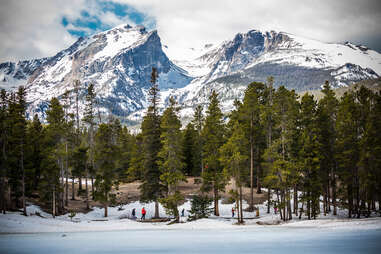
Colorado
As with Rainier, winter’s a huge part of the draw for Colorado’s crown jewel national park, which sees crowds thin (but not disappear) when the snow starts to fall. And fall. And fall. Visiting during winter means you’ll be losing access to certain iconic roadways like Trail Ridge, but you’ll make up for it by seeing the winter landscape in areas where cars aren’t going anyway. Snowshoeing and cross-country ski adventures range from quick in-and-out treks to multi-day tours where you’ll encounter alpine lakes, snowy meadows, frozen waterfalls, and only the hardiest of visitors.
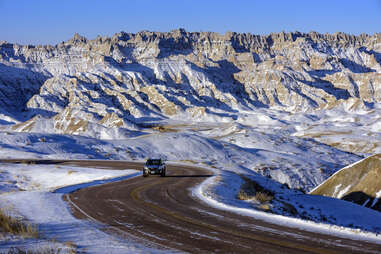
South Dakota
Less than 1 million people drop by South Dakota’s most gorgeous landscape annually, and come winter the place is virtually deserted (December sees a scant 8,400 people, while February tops out at 13,400) . What a stunning time to go full Dr. Manhattan and have 244,000 acres of Mars virtually to yourself, give or take a few bison. Snag a campsite under a blanket of stars if you’re hardy, or a cozy cabin (and maybe some donuts and buffalo burgers) in nearby Wall. Then strap on snowshoes or skis and get ready to truly know what it’s like to be tiny and gloriously alone in the wild.
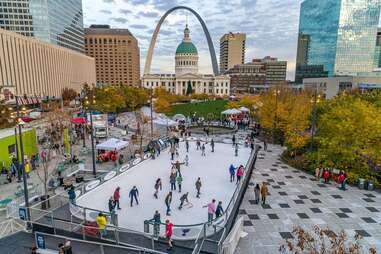
Missouri
Truth be told, we often skip over Gateway Arch, whose National Park status continues to baffle us since it’s, you know, a big-ass arch in the middle of St. Louis that’s perpetually clogged with road trippers. But thanks to the annual Winterfest (November 18 to December 31), the Arch finally earns a spot on our roundup of essential NP experiences. Sure, it’s more Rockefeller Center than Old Faithful thanks to its ice rink, but the charms of heated igloos, a full-force holiday light display, and magnificent views of St. Louis—which really is pretty in the winter—are hard to argue with. And hey, maybe Yellowstone would have made this list if they included a few s’mores stations like the ones here.
